[Published Bluebloods Sept/Oct 2020]
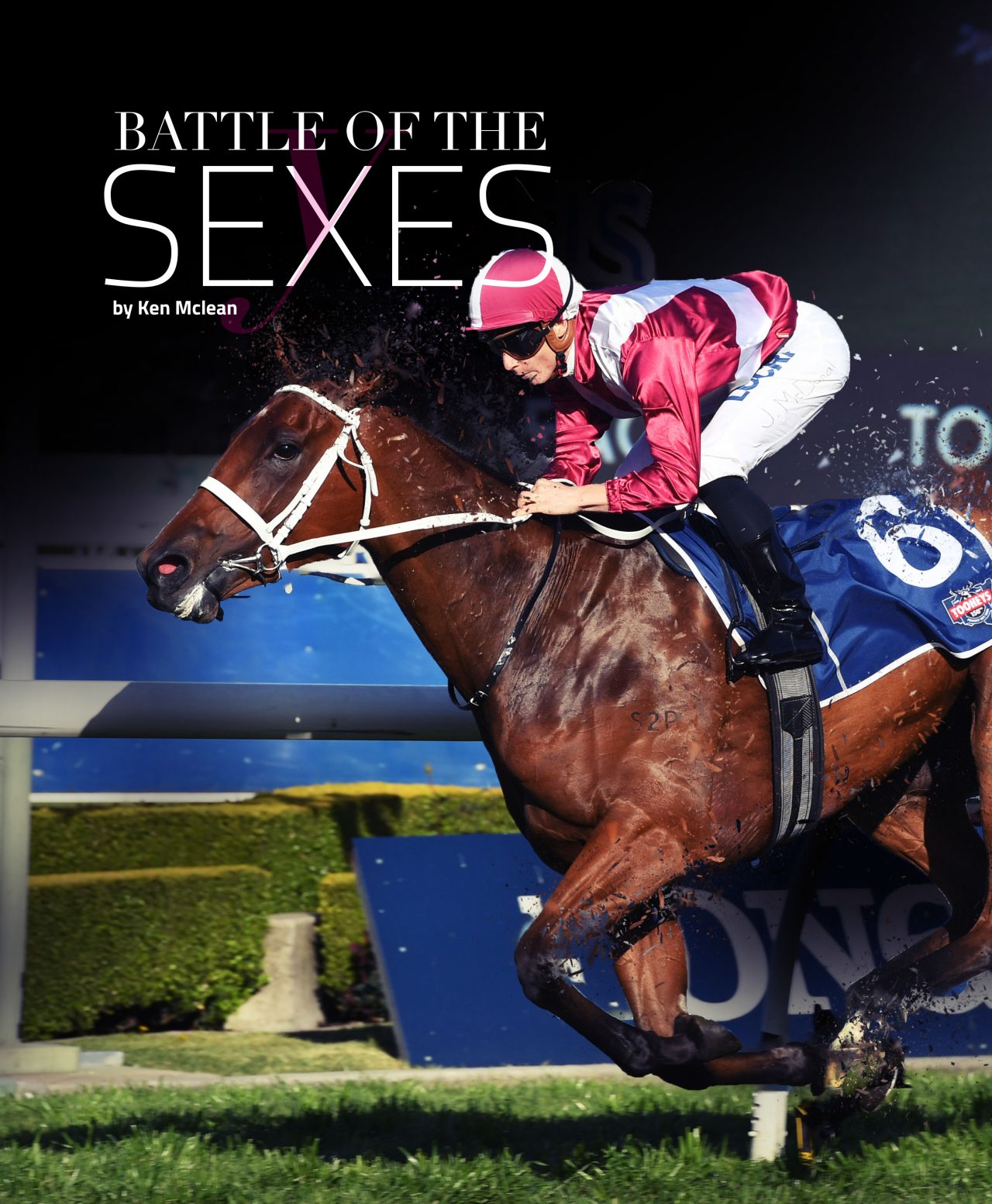
GENETIC COMPATIBILITY
BREEDING the thoroughbred racehorse remains an inexact science, despite interesting genetic research by professional companies. Simon Marsh, general manager of Watership Down Stud since 1992 for Lord and Lady Webber, stated in an interview: “If you have the greatest stallion in the world and the best mare in the world, there’s no reason why their progeny won’t be beaten by something that cost just 10% of the price”.
Unfortunately, breeding the best to the best and hoping for the best rarely produces a champion racehorse, but when it does, the pedigree of the athlete often reveals at least one common ancestor to enhance genetic compatibility. The racehorse genome’s 32 pairs of chromosomes written in 2.7 billion pairs of DNA was sequenced and published in 2009. It was a mammoth undertaking by the science community. The thoroughbred racehorse has 31 autosomal pairs of chromosomes as well as one pair representing the sex chromosomes (XY for males, or XX for females). While the nucleotide variability of the thoroughbred’s X chromosome is extremely high, it is quite low for the Y chromosome.
In the pedigree pattern of Gr.1 winners, I concluded that some appear to show what I term sex bias. What exactly do I mean? Have you never noticed certain pedigree patterns produce high-class performing colts yet fail to produce decent fillies who are just average performers? Vice versa, what about patterns that produce high-class fillies whose brothers are below average athletes? Skill is required to identify patterns in pedigrees. Great breeders analysed pedigrees to understand nicks and compatibility of strains. Tesio, Lord Derby, and Marcel Boussac were keen to study pedigrees to discover clues as to why specific lines worked in harmony to produce classic winners. They searched pedigrees back to the sixth generation or more.
Purging recessive genes
IN THE wild, harmful recessive genes in a breed are purged over time by natural selection. Only the fittest survive. In the wild hills of Northumbria, harmful recessive genes were purged from the unique herd of Chillingham cattle. During the past 300 years over 68 generations, no other cattle joined the herd and today they are strong and healthy, with good fertility but with a slight loss of size. They represent an extreme example of how inbreeding has purified the Chillingham gene pool and with natural selection, maintained soundness and fertility. Weak recessive genes were bred out of the gene pool. Genes are not the whole story in the making of champion performers. Education , Training, feeding, farrier work, veterinary care etc., are all significant environmental factors governing the progress of an athletic racehorse, as well as rider and care by stable staff.
Breeding methods
THE four methods or techniques most discussed and tested by thoroughbred breeders may be listed as follows:
a) Inbreeding
The strategy of using inbreeding as a technique is the aim to upgrade performance as a result of reinforcing superior ancestors on both sides of a foal’s pedigree within four generations. Inbreeding is used to try to fix desired type, speed and stamina by reinforcing high-class male and/or female ancestors present in both parents of a future foal. The idea is to recapture multiple genes from superior ancestors.
The most common technique used by horse breeders when designing pedigrees is where a superior male ancestor is reinforced only via sons (described as male only transmission). Others prefer to design pedigrees whereby the duplicated ancestor (stallion or mare) is reinforced via both sexes, son and daughter (described as sex balanced transmission) which provides for a wider collection of genetic characteristics from a duplicated ancestor, and deploys more impact on both sides of chromosomal pairings.
Incestuous inbreeding, such as father to daughter, rarely supplies decent performers but it can increase prepotency. Closely inbred examples are Ksar, champion racehorse in France and that wonderful taproot mare Tourzina. Today, most people believe incestuous inbreeding is far too risky to consider when aiming for a high-class athlete. The disadvantage of inbreeding as a method is its chance to increase undesirable characteristics in progeny, e.g. where two copies of recessive genes combine to cause weakness, such as “bleeding” from the lungs (exercise induced pulmonary haemorrhage), airflow obstruction, tendon weakness etc.
b) Line breeding
This method is a less intensive form of inbreeding. It allows for gaining benefits from inbreeding but at a distance and involves the multiple duplication of ancestors. By far the majority of Group and Graded stakes winners around the world are the result of line bred pedigrees, duplicating one or more ancestors. General consensus is that where inbreeding attempts to fix type as a consequence of careful selection, line breeding aims to achieve the same goal but at a safer distance.
c) Outcrossing
This method is always popular as it involves planning pedigrees with no common ancestor within five generations. The aim is to increase fitness and size due to hybrid vigour. It is a valuable tool to breed away from inbred strains. Structural weakness can often be corrected using outcrossing, and while it is consistently used successfully by animal breeders, it has limitations when breeding for performance animals.
Of course its success requires compatibility of multiple single strength genes to work harmoniously. Among the values of using outcrossing as a technique are:
it encourages the introduction of valuable new gene groupings
it is beneficial to improve or maintain fertility
it can increase size, and
any product of outcrossing can be bred back to the desired original inbred or line bred strain.
d) Outbreeding
Outbreeding Is a method defined as the unison of two inbred parents which have no common ancestor within five generations. The inbred ancestors are unrelated. For example, a foal whose father is inbred 3×4 to Northern Dancer, and whose mother is inbred 4×3 to Biscay is what we call an Outbred foal. Both parents are products of inbreeding, but duplicated ancestors in the parents are unrelated. This method is the least used.
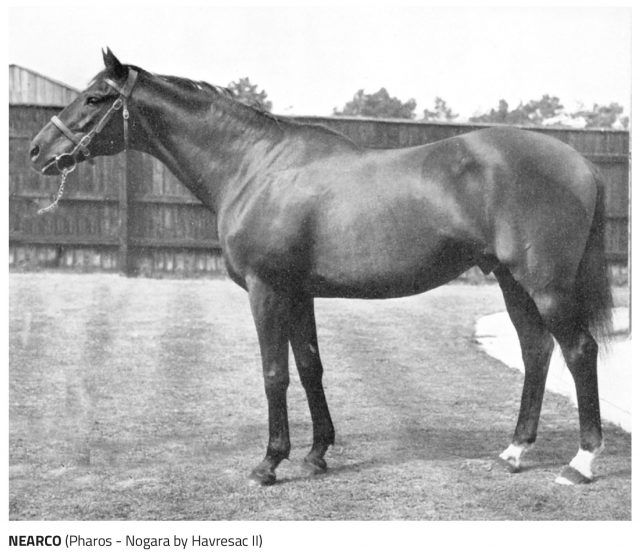
Conclusion:
WHEN selecting suitable stallion partners for mares and fillies, one should keep an open mind about what type of stallion might upgrade future foals. Apart from commercial considerations, be honest about any weakness mares possess, faults that need fixing. If the filly or mare has experienced weakness in her tendons or ankles, only consider proven, sound performers as partners. Check for clean airflow, decent temperament and all other traits your mare will require in a stallion partner. Great breeders who raced their home-breds needed sound runners and realised too much stamina to stamina ended up breeding plodders.
Federico Tesio, the Italian genius who trained and bred champions in Europe, used all four methods outlined. Towards the latter half of his life he favoured line breeding via both sexes to a superior ancestor. He and his devoted wife Donna Lydia, were ardent students of pedigrees and examined the pedigrees of all the best English and European classic winners.
Although not seriously interested in breeding pure sprinters, Federico Tesio acknowledged speed has to be part of a classic winner’s genetic make-up. With limited funds available each year, pedigree analysis was vital in the decision making process of Dormello’s mares and fillies. Tesio sent some of them to Ireland, England and France to test special pedigree patterns, but of course, not all were successful. They never are!
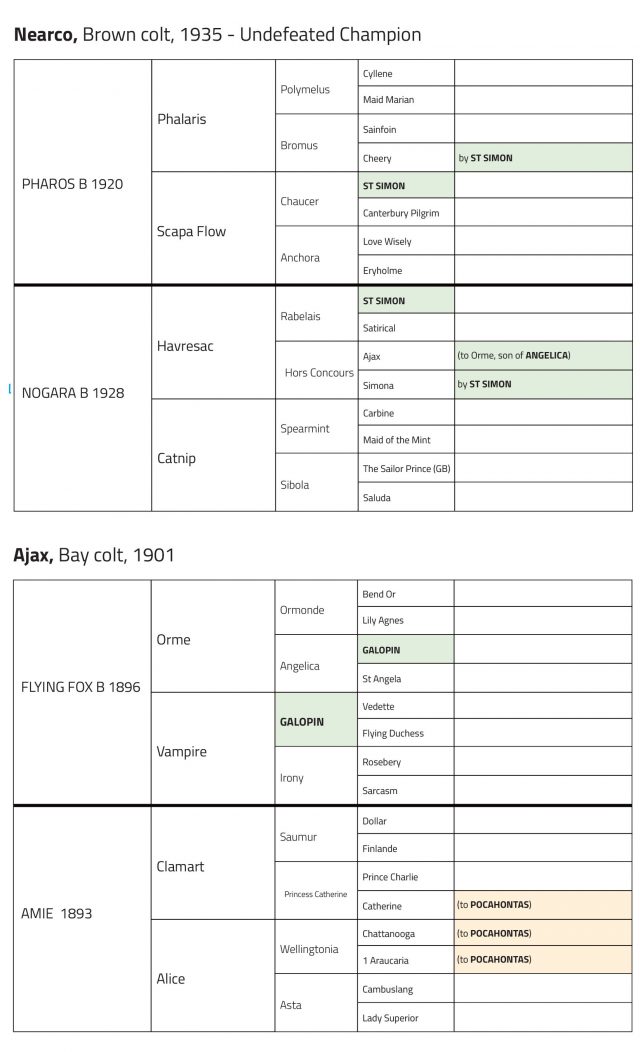 Readers might wish to re-examine the pedigree of his unbeaten champion Nearco because it is quite intricate in design (see pedigree). Tesio believed St. Simon was the superior ancestor to duplicate in pedigrees. He recognised St. Simon’s ability to upgrade mares. Other superior ancestors Tesio admired and duplicated were Ajax, Tracery and Blandford. Ajax was a sensational sire of high-class performers and sired champion Teddy, as well as Hors Concours, dam of Havresac II.
Readers might wish to re-examine the pedigree of his unbeaten champion Nearco because it is quite intricate in design (see pedigree). Tesio believed St. Simon was the superior ancestor to duplicate in pedigrees. He recognised St. Simon’s ability to upgrade mares. Other superior ancestors Tesio admired and duplicated were Ajax, Tracery and Blandford. Ajax was a sensational sire of high-class performers and sired champion Teddy, as well as Hors Concours, dam of Havresac II.
Even though these ancestors are found well back in today’s pedigrees, they still play major roles regarding the transmission of classic speed because they possessed many dominant genes. Ajax was by Flying Fox (inbred 3×2 to Galopin) from Amie by Clamart from Alice by Wellingtonia. He inherited racing class from the duplication of famous mare Pocahontas.
Now perhaps we can understand why when descendants of Nearco met up with descendants of Teddy it caused upgraded classic speed, intensifying energy. I think it has something to do with hyped up Mitochondria (the powerhouse of cells). Ajax inherited special genes from Angelica, own sister to the mighty St. Simon.
Tesio never liked to give away secrets but he did mention St. Simon was a stallion who changed the conformation of the English racehorse. Tesio believed St. Simon transmitted conformational differences such as a sloping croup and different shape of hocks that gave his descendants athletic advanatage. He attributed the difference in physical structure to genes transmitted from St. Simon’s broodmare sire King Tom, son of famous mare Pocahontas (by Glencoe). Pocahontas was one of the greatest mares in thoroughbred history and produced the great stallion Stockwell and his brother Rataplan as well as King Tom.
Havresac II was the perennial Leading Sire in Italy during this period and he sired champion filly Nogara who became the dam of Nearco. A pure bay horse, Havresac II was a dominant sire, inheriting most of St. Simon’s traits. The male line of Havresac II continues via unbeaten Ribot and his descendants. Havresac II inherited special genes from the combination of St. Simon’s son Rabelais with a daughter of Ajax.
Tesio always respected English Derby winner Sainfoin and noted how that stallion’s sister Sierra was the dam of champion sprinter Sundridge. He was not surprised when brother and sister turned up in the pedigree of Nasrullah
After researching the pedigrees of Tesio’s best performers I soon discovered he was very creative with thoroughbred pedigree patterns. His greatest failing was the over-use of English Derby winner Hurry On, a big horse, who despite covering quality mares, failed to deliver high-class runners for the Tesios.
Towards the end of my overseas trips I visited Dormello Stud south of the lovely little town of Stresa, set on the shore of Lake Maggiore. My wife and I were privileged to be given the opportunity to inspect hand-written notes by Donna Lydia in the private Dormello book, which recorded descriptions of foals born. These notes confirmed my belief that after 1945 the Tesios focused more attention on the duplication of ancestors via both sexes. The concept of sex-balanced pedigrees enables important groups of genes to be deployed on both sides of chromosomal pairs of an individual.
Because I believe so much in this concept, I decided to promote it in my four books. I applied it to design the pedigrees of champion performers in Europe and North America. From the same parents, I assumed a colt would inherit slightly different traits to his sister (different portions), and by combining the genes of colt and filly from the same parental gene pool, it could recapture some of the best genes at double strength.
Thus, having looked at pedigrees of stakes winners with duplication of St. Simon and his full sister Angelica (dam of Orme), I understood why Tesio planned the mating which produced Nearco, a colt who became champion racehorse and leading sire. I understood why he sent Nogara to France to be covered by Pharos. Yet, how come Tesio sold Nearco to England? Why did he decide not to stand the stallion in Italy? Perhaps it was because a war was coming and he needed the money.
Marcel Boussac
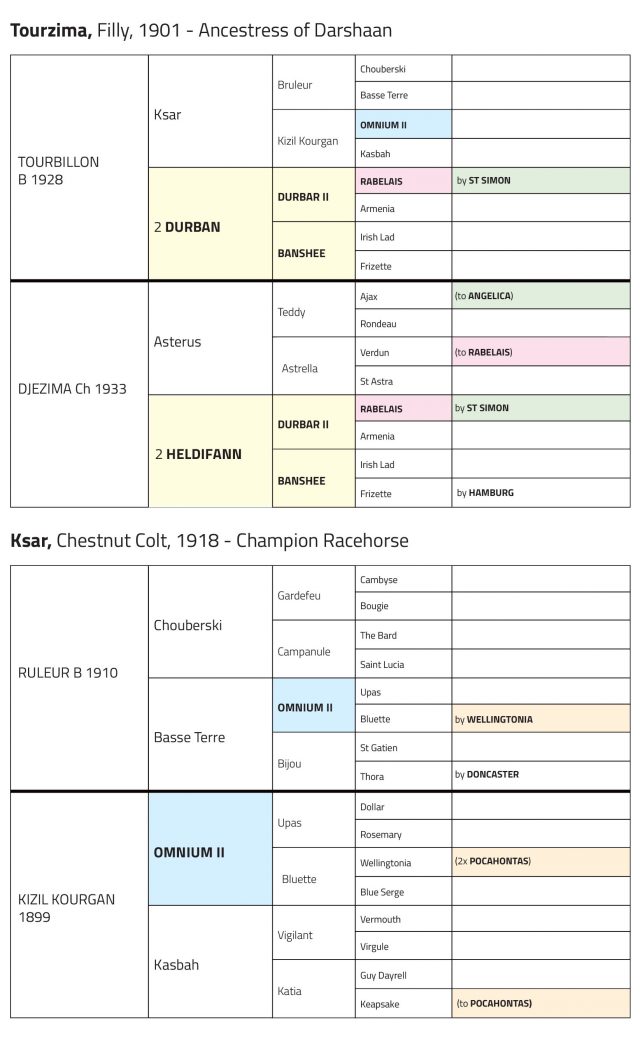 IN France, textile magnate Marcel Boussac began his breeding empire by mixing American and European strains in his homebred performers. Eventually he graduated to testing inbreeding to his stallions Tourbillon, Djebel, Pharis II, and to the outside stallion Teddy. His experiments with descendants of the Hanover mix with St. Simon established a dynasty of stakes winners.
IN France, textile magnate Marcel Boussac began his breeding empire by mixing American and European strains in his homebred performers. Eventually he graduated to testing inbreeding to his stallions Tourbillon, Djebel, Pharis II, and to the outside stallion Teddy. His experiments with descendants of the Hanover mix with St. Simon established a dynasty of stakes winners.
Tourzima was a famous broodmare inbred 2×2 to sisters Durban and Heldifaan (both by Durbar II from Banshee, a daughter of Frizette) and it was American-bred mare Frizette by Hamburg (son of Hanover) from Ondulee by St. Simon whose female line prospered. Her descendants ended up in the possession of the Aga Khan who bred Darshaan.
Marcel Boussac was influenced by Edmond Blanc and his successful breeding theories. Blanc was France’s most notorious gambler who became the owner and breeder of classic winners. He experimented with pedigrees that reinforced elite mare Pocahontas, dam of Stockwell, Rataplan and King Tom.
Edmond Blanc leased Wellingtonia, a stallion inbred to daughters of Pocahontas, to stand at stud in France, Wellingtonia soon proved an outstanding sire. His son Clover was the stallion’s first classic winner and was bred by Blanc from Princess Catherine, a mare line bred to Pocahontas via Stockwell and via her daughter Heroine of Lucknow. Blanc had purchased Princess Catherine especially to mate with Wellingtonia. The cross revealed five sources of Pocahontas via both sexes. Clover won the Prix du Jockey Club and progressed to win the Prix du Cadran. The colt was sold for big money to stand at stud in Russia.
Blanc predicted Wellingtonia would be a successful sire of winners because of a chance that prepotency would emanate from the clever close inbreeding to two daughters of Pocahontas. He predicted Wellingtonia’s strain would nick with descendants of Stockwell and King Tom, the best sons of Pocahontas, and he was absolutely correct! Edmond Blanc became friends with Marcel Boussac and advised him to patronize his chestnut stallion Ksar, a great champion whose 11 victories included two consecutive wins of the Prix de l’Arc de Triomphe.
Ksar was bred by Evremond de Saint-Alary and although purchased by Blanc, was raced in the name of Madame Edmond Blanc, Ksar was a sensation. He would also win the Prix de Salamandre, Prix Lupin, Prix du Jockey Club and Prix du Cadran and was reported to have had a large heart, which he passed on to his best son Tourbillon, bred and raced by
Marcel Boussac.
Blanc won a fortune in bets with his beloved Ksar who was the world’s leading money earner. A study of Ksar’s pedigree shows he was incestuously inbred to the versatile Omnium II by Upas from Bluette by Wellingtonia.
Prominent French breeder Evremond de Saint Alary raced Omnium II and considered him to be an ideal sort to experiment with inbreeding. He purposely designed the pedigree of Ksar (see pedigree). Omnium II was Leading Sire in France in 1902 and was a sound racehorse, His major victories include the Prix du Jockey Club, Prix de la Foret, Prix du Prince d’Orange and Prix du Cadran. One should recall another champion performer line bred to Pocahontas was Tracery (Rock Sand-Topiary) who had nine sources of Pocahontas in his ancestry, a rare pedigree pattern which influenced Tesio to acquire descendants of Tracery.
Marcel Boussac purposely bred Prix de l’ Arc de Triomphe winner Coronation V from a 2×2 inbreeding to Tourbillon. Yes, she was very temperamental, but it was an internal injury that prevented her from becoming a producer, not her intense inbreeding.
In England, Lord Derby and his stud manager Walter Alston enjoyed great success from inbreeding and line breeding to females, notably Pilgrimage, Canterbury Pilgrim and Selene’s family of Gondolette. Among athletes bred by Lord Derby were Hyperion, Pharos, Fairway, Fair Isle, Pharamond II, Sickle, Tranquil and Colorado.
Olin Gentry Senior who managed Idle Hour Farm and Darby Dan Farm in Kentucky designed the pedigree of four Kentucky Derby winners as well as Roberto, an English Derby winner. Olin Gentry became a close friend of mine in Kentucky and told me said he preferred to line breed rather than inbreed to high-class ancestors. An exception was Roberto who was an inbred individual. Olin often duplicated Black Toney, Blue Larkspur and Teddy (the latter sire of La Troienne, Bull Dog and Sir Gallahad III) to upgrade performance in racing stock for John Galbreath, owner of Darby Dan Farm.
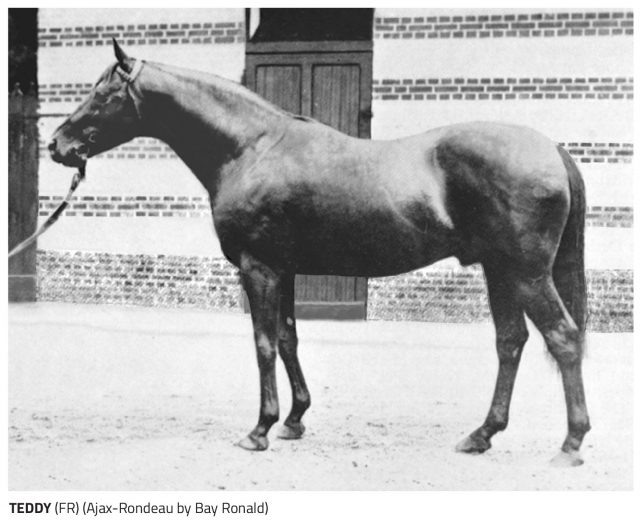 Sir Patrick Hogan was an avid fan of pedigree research. Like many other Kiwis, he noted imported sons of great English mares were siring major stakes winners, especially Mellay. Sir Patrick saw potential by importing the well-bred Sir Tristram (Sir Ivor-Isolt by Round Table) who became champion sire in Australian and New Zealand and put Cambridge Stud on the global map.
Sir Patrick Hogan was an avid fan of pedigree research. Like many other Kiwis, he noted imported sons of great English mares were siring major stakes winners, especially Mellay. Sir Patrick saw potential by importing the well-bred Sir Tristram (Sir Ivor-Isolt by Round Table) who became champion sire in Australian and New Zealand and put Cambridge Stud on the global map.
In the pedigree of Sir Tristram we find Selene duplicated 5×4 via son Pharamond II and via daughter All Moonshine. We also find Lavendula II, a daughter of Pharos, as grand-dam of Turn-to and My Babu, as well as the valuable 4 x 3 inbreeding to champion sire Princequillo, an ancestor out of a daughter of Papyrus, best son of Tracery. These high-class duplicated ancestors increased Sir Tristram’s prepotency, but the stallion developed a nasty disposition and needed care in the breeding shed.
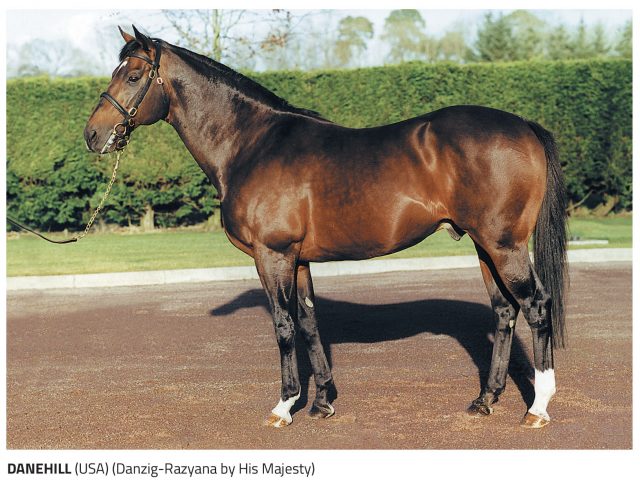 The question begs how much should we inbreed to Danzig and his son Danehill? Group winners with a double or triple of the brilliant Danzig have already appeared and most with sex balanced patterns – successful patterns showing a “son” of Native Dancer and reinforcement of Teddy. The same applies to Danehill, who carries stamina from Ribot and Tracery elements of his broodmare sire His Majesty. Of course Danehill, with his unique inbreeding to Natalma (Native Dancer-Almahmoud by Mahmoud) merits consideration to duplicate him, but perhaps not too close up in pedigrees.
The question begs how much should we inbreed to Danzig and his son Danehill? Group winners with a double or triple of the brilliant Danzig have already appeared and most with sex balanced patterns – successful patterns showing a “son” of Native Dancer and reinforcement of Teddy. The same applies to Danehill, who carries stamina from Ribot and Tracery elements of his broodmare sire His Majesty. Of course Danehill, with his unique inbreeding to Natalma (Native Dancer-Almahmoud by Mahmoud) merits consideration to duplicate him, but perhaps not too close up in pedigrees.
We know Danehill nicks with mares possessing a “son” of Native Dancer, especially via Raise a Native and Mr. Prospector. Danehill happens to be linebred to Teddy. We find champion Buckpasser (sire of Spring Adieu) is inbred 4×4 to Teddy via Bull Dog, and daughter La Troienne. Valuable genetic impact occurs whenever Teddy’s sire Ajax is mixed with descendants of Nearco – it is a blend of similar genes. Teddy’s strain links up wonderfully well with Nearco’s best sons Nearctic, Nasrullah and Royal Charger. Explosive electricity can come from the clever duplication of Teddy’s sire Ajax, an undefeated champion.
Should we be worried about the large number of mares in Australasia that carry Danzig and his son Danehill? No, not really. Decades ago, breeders cried out about too many stallions standing at stud from Star Kingdom’s sire line. A few generations later his male line became obscure and silenced the critics. Star Kingdom left a lasting legacy with his descendants, but not from the extension of his sire line. Kaoru Star, Luskin Star, Biscay, Bletchingly, Todman and Noholme regularly appear in pedigrees of the dams of Group winners. Star Kingdom’s strain is genetically compatible with descendants of Nearctic and Northern Dancer.
Miswaki, sire of Urban Sea who produced Galileo and Sea the Stars, is a stallion establishing worldwide importance. When descendants of Miswaki meet up with any of Northern Dancer’s tribe, the cross gave sex balance of superior ancestors. The mix involves son and daughter of Native Dancer, plus sex balance to Teddy via Bull Dog (twice) and La Troienne. The cross reinforces Nearco and Nasrullah. Actually, Teddy (by Ajax) has always been important for Northern Dancer’s success. Danzig has Teddy twice in the make-up of the inbred Crafty Admiral, sire of Admiral’s Voyage.
Genetic diversity will control the development of future generations despite some stallions covering more than 200 mares in a breeding season. I have a suspicion John Magnier (Coolmore) and his sons Tom and Michael Vincent are already planning ahead to make available newer strains to mix with mares by Danehill and Galileo. Coolmore recently purchased the breeding rights of Belmont Stakes-Gr.1 and Travers Stakes-Gr.1 winner Tiz the Law, who is by Tapit’s young son Constitution, and have finalised buying Wotton Bassett (by Ifraaj) from France to stand in Ireland. Coolmore stands US Triple Crown champions American Pharoah and Justify. I am a big fan of American Pharoah because I love his broodmare sire. I predict American Pharoah will be very compatible with descendants of Nijinsky II, Storm Cat, Giant’s Causeway, Danehill and Galileo.
John Messara (Arrowfield) and son Paul are also seeking new strains. They decided to shuttle several Yoshida stallions from Hokkaido, including sons of champion Deep Impact.
Pierro has only one source of Northern Dancer via his daughter Sky Song, and already succeeds with mares with Danehill’s strain, especially mares by Redoute’s Choice. I Am Invincible has one line of Danzig and succeeds when Northern Dancer is reinforced, but leading sire Snitzel is already line bred four times to Northern Dancer so one has to think carefully about how select sire partners for his daughters.
Champion racehorses come in all shapes and sizes, ranging from the little ones like Northern Dancer and Star Kingdom to big ones like Secretariat. Sadly, thoroughbreds around the globe continue to carry genetic traits that cause heritable health problems such as entrapped epiglottis, soft palate and left laryngeal paralysis, which are serious air-flow obstructions. While breathing problems are mostly genetic (often the result of doubling up hidden, negative recessive genes) they are also caused by environmental factors. If a filly needs surgery for airflow obstruction, should she go to stud? Will she produce progeny with the same weakness?
What about fillies who injure a tendon and never race? Or fillies who tie-up or those so highly-strung they always misbehave at the barrier on race day? Is stubborn temperament a fault? Is it transmissible? Well, nobody can say with confidence these fillies will never produce Group winners. If they are mated carefully with sound, compatible stallions success can be achieved.
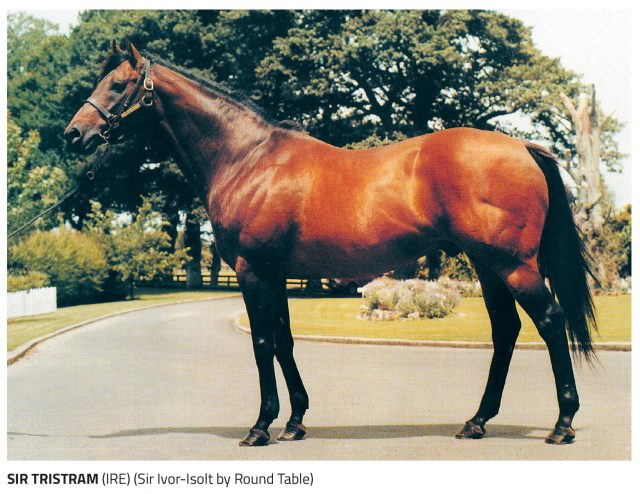 Regarding the technique called line breeding, out of interest, here is an excerpt by famous US journalist Avalyn Hunter who wrote in The Blood-Horse magazine many years ago the following about Northern Dancer’s ancestry.
Regarding the technique called line breeding, out of interest, here is an excerpt by famous US journalist Avalyn Hunter who wrote in The Blood-Horse magazine many years ago the following about Northern Dancer’s ancestry.
“The great stallion Northern Dancer is an excellent example of a line-bred pedigree. While on the surface he was only mildly inbred with a 4×5 cross to Gainsborough (one cross at the fourth generation and one in the fifth) he had 23 crosses to the great English racer and sire St. Simon within sixth through eighth generation. He also had five crosses (6x6x6x8x7) of the important mare Canterbury Pilgrim, a 3×6 cross of another important mare Selene, a 4×5 cross to the top sire Polymelus, and a 5×6 cross to Derby Stakes winner Spearmint”.
Northern Dancer transmitted genes that improved overall athletic performance, inheriting exceptional energy from unique muscle composition quite different to other stallions. His paternal grandsire Nearco and maternal grandsire Native Dancer were two of the most celebrated performers ever seen on turf and dirt and his second dam is by Mahmoud (Blenheim-Mah Mahal by Gainsborough-Mumtaz Mahal) who set a race record in his English Derby victory over a mile and a half. Nevertheless, had Northern Dancer never covered mares with a source of French champion Teddy (best son of Ajax), I truly believe he would not have become a champion sire.
If possible, I suggest readers try to find time to check out the pedigree of famous German mare Allegretta who is the dam of King’s Best and Urban Sea. She represents an example of line breeding to multiple ancestors. In her pedigree, outstanding sire Alchimist is duplicated via daughter Aralia and son Birkhahn. German mare Aster is reinforced via two daughters, Aralia and Asterblute – so okay, Aralia is doubled in the pedigree. Further back in the fifth generation are English Derby winners Hyperion and Bahram duplicated, as well as Teddy, via his sons Asterus and Aethelstan.
Allegretta has Abbot’s Trace (by Tracery) in her pedigree. This is rather interesting. He appears via middle distance stakes winner Abbot’s Speed. Now, we must remember Nearctic’s dam Lady Angela is by Hyperion from a daughter of Abbot’s Trace. Maybe Teddy and Tracery help to explain why Allegretta and her daughter Urban Sea were able to produce classic winners when connected with descendants of Nearco and Nearctic.



